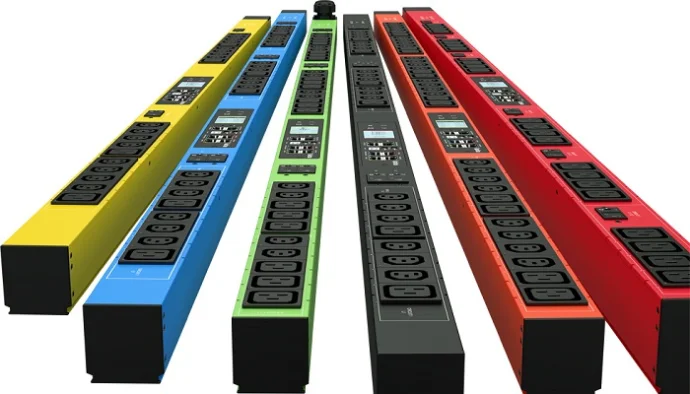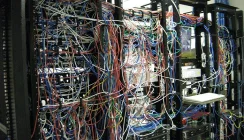How Selecting The Right PDU Improves Power and Energy Management
As soon as you start to add multiple devices to your server rack, power management can become an issue. The use of Power Distribution Units (PDUs) with some form of metering or intelligent IP connection can help to overcome this and provide a pathway for the future scale-up of your IT deployment.
What is a Power Distribution Unit or PDU?
Let’s start with a basic PDU or socket strip. We have all used these in our offices and homes to connect multiple devices to a single power socket. A Basic PDU is very similar to a power strip but one designed for installation into a standard 19inch server rack or cabinet. The PDU will typically have IEC320 outlets, some form of resettable circuit breaker and a fixed form factor for either horizontal or vertical mounting.
A basic-type power distribution unit is ideal for single server rack users running a small office network via a server and network peripherals. More complex server rooms and datacentres will typically install more sophisticated power distribution units including metered and intelligent types.
Metered PDUs as the name suggest have a meter built-into the device to provide power and energy management information. Typical values include Volts, Amps, Frequency, Watts/kW, VA/kW and kilo-Watt hours (kWh).
Smart or Intelligent PDUs offer more sophisticated metering and outlet socket control. Sometimes referred to as a switched PDU, an intelligent PDU can be connected to the local IP network via SNMP card and RJ45 connector. Power and energy management information is available at the total PDU level and for each socket outlet. Management software on the network can be used to reboot individual sockets, providing a degree of remote hardware reboot and disconnection as required.
AC Power Supplies
Most PDUs are powered form a local AC (alternating current) power source via a trailing lead. For a server rack the most common source of AC power is an uninterruptible power supply. The UPS may be a 19inch rackmount type or one installed to power a complete server room or datacentre i.e. a centralised UPS. If a UPS is installed, each PDU outlet is supplying uninterruptible power to the server and IT loads.
Switch Mode Power Supply Ratings and UPS Sizing
When you check a server datasheet, the power supply is often stated at its maximum power rating in Watts. This is the maximum power the switch mode power supply (SMPS) will provide. In practice this figure is not reached for two reasons.
The first is ‘headroom’. The power supply has been chosen as the nearest available or required within the server design specification. Most are sized to allow an 80% headroom. This is sound engineering practice for any electronic or electrical device, including uninterruptible power supplies.
The second is that most power supplies run at half their load in reality. A good rule of thumb therefore is to take the specification rating i.e. 1400W and to divide this by two give and use 50% of the rating for sizing the typical maximum power requirements i.e. 700W. Even then, unless the server is running at full work load it may not be reached.
This rule of thumb applies for most servers, but care should be exercised. If in doubt a check with the server manufacturer’s technical support line or website may provide more information. The Server Room Environments projects team can also provide support, based on installations we have completed and our own knowledge bank.
N+X Power Sources
Some IT servers have redundant power supplies. What this means is that each server has two switch mode power supplies to supply power to internal circuits, microprocessors and fans. The two power supplies typically share the load and if one fails, the other can power the complete load itself.
Where dual power supplies are installed both these can be supplied from two separate power sources. Often these are referred to as ‘A’ and ‘B’ supplies. In the case of PDUs this means using one PDU or set of PDUs on the ‘A’ leg and one on the ‘B’ leg. Each leg may be supplied from different AC power sources i.e. two different UPS to maintain the N+X resilience and the power circuit could also incorporate an automatic or static transfer switch.
Whilst the majority of installed PDUs are for single phase installations, three phase PDUs are also available. Of course, these require a more complex electrical supply in the form of a 3-phase electrical circuit and uninterruptible power supply.
If any loads require a DC source of power, a DC PDU must be installed.
PDU Management and IEC to IEC Power Cords
Even if you only use one power distribution unit it is important to label power cords and to keep a log. The control document identifies the loads connected to the socket outlet(s) and PDU. In complex installations this can make it easier to identify loads for disconnection and which PDU or socket outlet to add new loads to.
Some of the PDU manufacturers our projects team works with provide coloured PDUs. This makes it easier to identify the power legs ‘A’ or ‘B’ used within a server rack. Coloured power cords are also available.
Outlet Monitoring
For complex server room and datacentre installations intelligent PDUs are the preferred option over basic or metered PDUs. Intelligent PDUs have plug-in SNMP cards for network IP management and allow power monitoring at their outlet socket level and at circuit breaker and branch circuit levels. The information gathered can assist with:
- Capacity Planning: in terms of having real time and true measurement of the Apparent and Real power used within the server room or datacentre facility
- New Device Installation: as soon as a new server, storage or network device is connected its power draw is immediately known
- Energy Efficiency: improving server utilisation and removing ‘vampire’ energy usage from the circuits
- Security: with access via the front cabinet door controlled over an IP network via the PDU
- Prevent Cascade Failures: by setting circuit breaker thresholds, it is possible to mitigate against a single power supply going short-circuit through automatic or manual disconnection
- Breaker Failure: breaker monitoring identifies when a specific PDU breaker trips and for it to be reset quickly
- Ambient Management: using plug-in temperature probes within the server racks whose analogue data can be read over a network via an intelligent PDU
- Branch Circuit Monitoring: for three phase PDUs to ensure branch and phase load balancing
- Billing: in colocation datacentres or where there are shared server cabinets
- Cabling: with improved labelling and management of power cords
Together these combined factors can help to lower the risk of unplanned for downtime and improve the overall resilience of the IT infrastructure.
Summary
Managing critical power is an important aspect within any server room or datacentre environment. Most organisations will run some form of uninterruptible power and possibly a standby power generator. Within the server rack itself, the benefits of correctly specified and sized power distribution are often overlooked. PDUs are the last segment of any critical power protection plan and when specified and installed correctly, can add to the site’s overall resilience and power management efficiency.


























